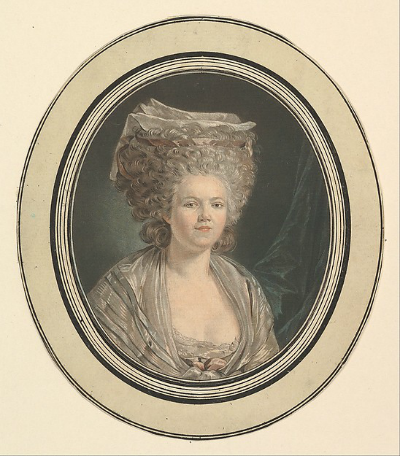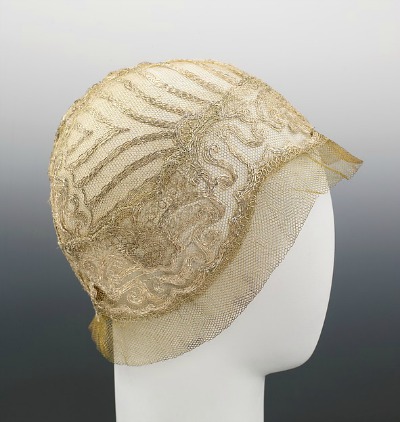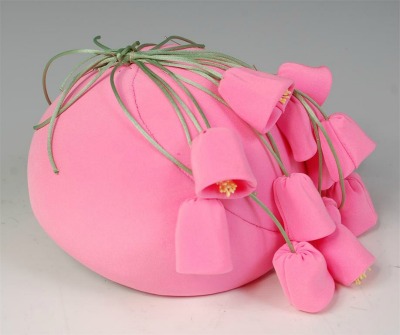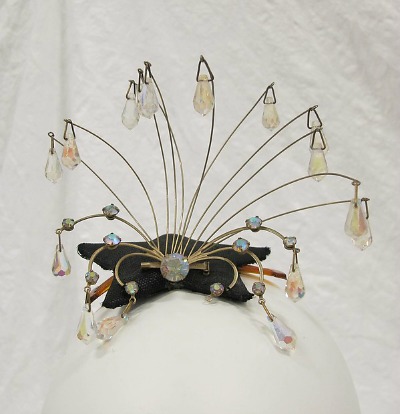A leader in the fashion industry since the Middle Ages, the Italian City of Milan, along with Paris, New York, and London, was considered one of the world's leading fashion capitals. The merchants who brought these highly revered goods from Milan were known as "milleners."
Eventually the term millener evolved into millinery and is now primarily associated with hatmaking. While one who makes hats for men is considered a hatmaker, a person involved in the designing, making, decorating, or selling of hats for women is known as a milliner.
Nineteenth Century Millinery
 |
| Caroline Reboux Toque 1913-1915 ©Metropolitan Museum Gift of Mrs. Andrew Winton Roth |
Eventually the term millener evolved into millinery and is now primarily associated with hatmaking. While one who makes hats for men is considered a hatmaker, a person involved in the designing, making, decorating, or selling of hats for women is known as a milliner.
Initially worn for religious reasons or as a protection from the weather, hats became a symbol of a woman's social status as early as the 16th century.
Early Millinery History
The Bergere or milkmaid hat is a style frequently seen in mid-eighteenth century paintings. The flat brimmed straw hat with a shallow crown was adorned with flowers and tied at the neck with ribbons.
The Bergere or milkmaid hat is a style frequently seen in mid-eighteenth century paintings. The flat brimmed straw hat with a shallow crown was adorned with flowers and tied at the neck with ribbons.
Celebrated French milliner Marie-Jeanne Rose Bertin is credited with bringing haute couture to Versailles and to Queen Marie Antoinette's Court. Her elaborately decorated headdresses worn with an elevated hairstyle or "pouf" became mode en vogue and the forerunner for French couture millinery.
 |
| Mademoiselle Marie-Jeanne Rose Bertin Dressmaker to Queen Marie Antoinette Etching by Jean Francois Janinet |
Nineteenth Century Millinery
As the 19th century millinery styles shifted to bonnets embellished with ribbons, gauze, flowers, or feathers, Paris millinery designers reigned supreme with these couturiers requesting their patrons address them as Madame. Most noted milliners from that era were Madame Victorine, Madame Herbault, Madame Agnes, and Madame Guerin.
Betsy Metcalf is remembered as one of Colonial America's first milliners and considered a trendsetter with her creation of silk lined and ribbon trimmed straw hats.
Betsy Metcalf is remembered as one of Colonial America's first milliners and considered a trendsetter with her creation of silk lined and ribbon trimmed straw hats.
Women's magazines such as Harper's Bazaar, Journal des Dames et des Modes, and Parisian Hat Company featured the latest millinery styles for fashionable women. Founded by the Butterick Publishing Company, the monthly magazine, Delineator, not only let women fashion their own clothes in the latest styles but make bonnets to match.
Due to the 1800's westward expansion, many American women resorted to Montgomery Ward and Sears & Roebuck catalogs for their clothing and millinery needs.
 |
| Delineator Magazine August 1894 |
Due to the 1800's westward expansion, many American women resorted to Montgomery Ward and Sears & Roebuck catalogs for their clothing and millinery needs.
Twentieth Century Milliners
The classic cloche style hat led the charge in early 20th century millinery fashions. First designed in 1908 by Caroline Reboux and popularized by Coco Chanel, it quickly became a fashion mainstay with other fashion houses quickly following suit with their own version of the bell shaped Art Deco styled hat. The design was worn for evening wear, bridal wear, or as a utilitarian or everyday hat.
As hats were considered de rigueur, couturiers Christian Dior, Jean Patou, Cristobal Balenciaga, and Nina Ricci kept their own millinery ateliers. Parisian trained Lilly Dache built an American millinery empire with Hollywood enthusiasts Joan Crawford, Lillian Gish, Louise Brooks, Marlene Dietrich, and Betty Grable sporting her cloche hats, snoods, and toques.
Exemptions of second hand clothing, workers' overalls, blackout cloth, anti-gas garments, shrouds, and hats during European and American wartime rationing allowed the millinery market to thrive. Hats were not only a fashion statement but a morale booster during the high fashion famine.
First establishing her New York millinery salon in 1938, creative genius Sally Victor's career would span three decades with First Ladies' Eleanor Roosevelt, Mamie Eisenhower, and Jacqueline Kennedy among her most loyal patrons.
After a twenty year partnership with Frederic Hirst, John P. John, launched his own millinery salon in New York. He would be known as Mr. John and was as revered for his millinery talents as Christian Dior was for his couture. Famous clients included Marilyn Monroe, Lauren Bacall, and the Duchess of Windsor.
Simone Mirman made her mark in the millinery field during World War II where she was able to create her hats from mere scraps of fabric and what little trim she was able to acquire. Couture greats Norman Hartnell, Christian Dior, and Hardie Ames requested she fashion hats for their clientele. Simone Mirman admirers included Queen Elizabeth II and Princess Margaret.
Australian born milliner Frederick Fox was the chief hat designer for England's royal family and is credited with creating over 350 of Queen Elizabeth's finest hats. Although first thought to have designed the unique, pink bells chapeau worn by Queen Elizabeth for her Silver Jubilee celebration, it was later disclosed the famed Simone Mirman's tag is in the hat.
Except for the Kentucky Derby and for England's royalty, the demand for hats began to wane in the 1960's. One of the last great fifties' milliners was Bill Cunningham. Under the label William J., he enjoyed designing hats with a whimsical flare. During the 1950's, Mr. Cunningham also designed fashions for the exclusive dress shop Chez Ninon.
Many of society's most stylish women shopped Chez Ninon. In an interview with New York Magazine, Cunningham states Jacqueline Kennedy had been coming to the New York salon since she was a child. Too distraught to come in to shop when President Kennedy was assassinated, Mrs. Kennedy sent him a Dior suit she had previously bought from the salon to have dyed black. He felt she needed assistance from someone with whom she was close and could trust.
True to her motto of dressing women from "Hat to Hem," Hattie Carnegie enjoyed a prosperous millinery business. She is best known for her Carnegie Blue suits, beaded and sequined ballgowns, and aurora borealis jewelry. She was also a mentor to fashion giants Norman Norell, Travis Banton, Claire McCardell, Pauline Trigere, and Jean Louis. Incidentally, a very young Lucille Ball modeled at Hattie Carnegie's salon during the 1920's.
Known as the Mad Hatter, Benjamin B. Green-Field, the millinery genius behind the label Bes-Ben, is noted for his outrageously quirky hats made from fantastical objects. More than just a hat, the highly coveted and very expensive Bes-Ben was a coiffure ornament.
As was the norm in the millinery business, Cuban born Adolfo Sardina was an apprentice for Cristobal Balenciaga before joining the New York based wholesale company Emme, Inc. He would later state he did not enjoy making hats and in the sixties his focus turned to designing clothes.
Although the founder of Henri Bendel, known for development of today's department store "shop within a shop" mode, died in the 1930's, the iconic New York millinery shop has transferred ownership and is now a nationally recognized accessories company. A 1950's Henri Bendel hat is still highly valued.
Major fashion houses such as House of Dior, House of Balenciaga, Chanel, House of Lanvin, and Pierre Balmain continued to carry their own line of designer hats with the latest styles in ready to wear found in department stores Bergdorf-Goodman, B. Altman & Co., Horrockses, and I. Magnin.
If you are fortunate enough to find yourself in possession of one of these fifties' millinery prizes, you have to display it on one of our friend Marge's Mannequins. Click HERE to choose your favorite. I have Paula on my Christmas Wish List.
 |
| House of Lanvin 1925 Evening Cloche ©Metropolitan Museum Gift of Mrs. Frederick H. Prince, Jr. |
As hats were considered de rigueur, couturiers Christian Dior, Jean Patou, Cristobal Balenciaga, and Nina Ricci kept their own millinery ateliers. Parisian trained Lilly Dache built an American millinery empire with Hollywood enthusiasts Joan Crawford, Lillian Gish, Louise Brooks, Marlene Dietrich, and Betty Grable sporting her cloche hats, snoods, and toques.
Exemptions of second hand clothing, workers' overalls, blackout cloth, anti-gas garments, shrouds, and hats during European and American wartime rationing allowed the millinery market to thrive. Hats were not only a fashion statement but a morale booster during the high fashion famine.
First establishing her New York millinery salon in 1938, creative genius Sally Victor's career would span three decades with First Ladies' Eleanor Roosevelt, Mamie Eisenhower, and Jacqueline Kennedy among her most loyal patrons.
 |
| Sally Victor 1936 ©Metropolitan Museum Gift of Sally Victor, Inc 1944 |
After a twenty year partnership with Frederic Hirst, John P. John, launched his own millinery salon in New York. He would be known as Mr. John and was as revered for his millinery talents as Christian Dior was for his couture. Famous clients included Marilyn Monroe, Lauren Bacall, and the Duchess of Windsor.
Simone Mirman made her mark in the millinery field during World War II where she was able to create her hats from mere scraps of fabric and what little trim she was able to acquire. Couture greats Norman Hartnell, Christian Dior, and Hardie Ames requested she fashion hats for their clientele. Simone Mirman admirers included Queen Elizabeth II and Princess Margaret.
Australian born milliner Frederick Fox was the chief hat designer for England's royal family and is credited with creating over 350 of Queen Elizabeth's finest hats. Although first thought to have designed the unique, pink bells chapeau worn by Queen Elizabeth for her Silver Jubilee celebration, it was later disclosed the famed Simone Mirman's tag is in the hat.
 |
| Frederick Fox Replica Simone Mirman Hat worn by Queen Elizabeth II Silver Jubilee Lacy, Scott & Knight Auctions |
Except for the Kentucky Derby and for England's royalty, the demand for hats began to wane in the 1960's. One of the last great fifties' milliners was Bill Cunningham. Under the label William J., he enjoyed designing hats with a whimsical flare. During the 1950's, Mr. Cunningham also designed fashions for the exclusive dress shop Chez Ninon.
 |
| Bill Cunningham under label William J 1950's ©Metropolitan Museum Gift of Bill Cunningham |
Many of society's most stylish women shopped Chez Ninon. In an interview with New York Magazine, Cunningham states Jacqueline Kennedy had been coming to the New York salon since she was a child. Too distraught to come in to shop when President Kennedy was assassinated, Mrs. Kennedy sent him a Dior suit she had previously bought from the salon to have dyed black. He felt she needed assistance from someone with whom she was close and could trust.
True to her motto of dressing women from "Hat to Hem," Hattie Carnegie enjoyed a prosperous millinery business. She is best known for her Carnegie Blue suits, beaded and sequined ballgowns, and aurora borealis jewelry. She was also a mentor to fashion giants Norman Norell, Travis Banton, Claire McCardell, Pauline Trigere, and Jean Louis. Incidentally, a very young Lucille Ball modeled at Hattie Carnegie's salon during the 1920's.
Known as the Mad Hatter, Benjamin B. Green-Field, the millinery genius behind the label Bes-Ben, is noted for his outrageously quirky hats made from fantastical objects. More than just a hat, the highly coveted and very expensive Bes-Ben was a coiffure ornament.
As was the norm in the millinery business, Cuban born Adolfo Sardina was an apprentice for Cristobal Balenciaga before joining the New York based wholesale company Emme, Inc. He would later state he did not enjoy making hats and in the sixties his focus turned to designing clothes.
 |
| Bes-Ben "Mad Hatter" Hat ©MetMuseum Gift of Muriel Kallis Newman |
Although the founder of Henri Bendel, known for development of today's department store "shop within a shop" mode, died in the 1930's, the iconic New York millinery shop has transferred ownership and is now a nationally recognized accessories company. A 1950's Henri Bendel hat is still highly valued.
Major fashion houses such as House of Dior, House of Balenciaga, Chanel, House of Lanvin, and Pierre Balmain continued to carry their own line of designer hats with the latest styles in ready to wear found in department stores Bergdorf-Goodman, B. Altman & Co., Horrockses, and I. Magnin.
If you are fortunate enough to find yourself in possession of one of these fifties' millinery prizes, you have to display it on one of our friend Marge's Mannequins. Click HERE to choose your favorite. I have Paula on my Christmas Wish List.

No comments:
Post a Comment